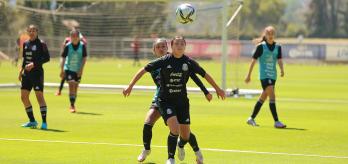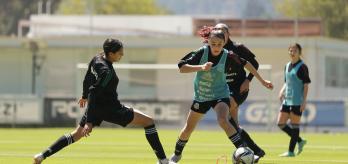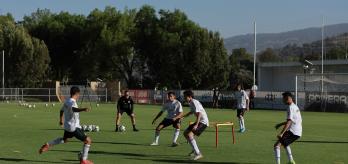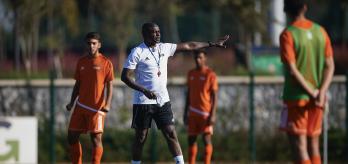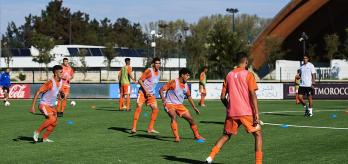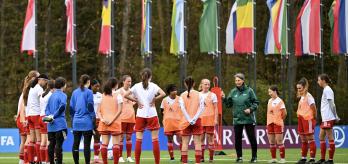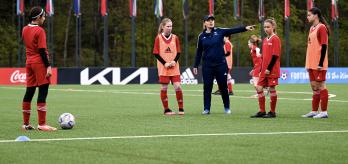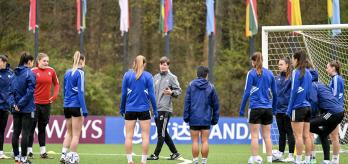During this session, Saïd Chiba, the former assistant coach of the Morocco national team and the current coach of the U-17 team, takes a group of 22 players through three exercises to develop their understanding of the defensive principles required to form a good mid-block. After a group warm-up, the outfield players are split into two groups of ten for a game called the rivière, in which the coach is able to introduce the basic principles of defending in a mid-block by setting up a line of four players against two groups of three attackers. The session then progresses into a game of 10-a-side stop-ball on a small pitch in which the coach can develop these principles collectively before finishing with an 11-a-side match on a full-size pitch.
Session overview
Key coaching points
-
To have a compact block that moves in a coordinated and synchronised way to reduce the opposition's playing space and to prevent them from progressing while forcing them into lower-risk areas.
-
Defending players must constantly think about protecting the central channel as a priority to prevent the opposition from advancing towards goal.
-
The defending team in a mid-block must be patient in the defensive phase, allowing the opposition to pass the ball around in their initiation zone, while defending on the front foot to prevent plays between the lines and in gaps.
-
The players must understand when to press and when to hold their position. The player closest to the ball must close down the player in possession to harry them while their team-mates nearby cover them and the others move across as a unit to close down the area around the ball.
-
The team's tactical leaders (generally the central defenders and/or defensive midfielders) are responsible for the team's defensive set-up as they can see the whole pitch. They have to use that information and communicate with their team-mates to help them with their positioning and to guide their decision-making.
Part 1: Closing down, covering and defensive shuffling
This exercise aims to introduce the first defensive principles of a mid-block, such as closing down, covering and defensive shuffling (moving across as a unit). The players are split into two teams of three (the forwards) and one team of four (the defenders), who each take up an area on the pitch. The objective for the defenders is to prevent the forwards from moving the ball between their two teams through the central zone.
-
A pitch measuring 20 by 15 metres is split into three areas of equal width.
-
The central zone is taken up by four defenders, while there are three forwards in each of the two outside zones.
-
All players have to stay in their respective zones.
-
The game always starts with the ball in one of the outside zones.
-
The forwards try to pass the ball from one outside zone to the other without the defenders intercepting it.
-
The forwards are limited to a maximum of two touches and can only pass the ball along the ground, but they can make an unlimited number of passes within the same outside zone.
-
Whenever the defenders win the ball back, they return it to the forwards, who start a new phase of possession.
-
The forwards are encouraged to play quickly while in possession so that the defenders have as many situations as possible to defend against.
-
Understand individual defensive responsibilities within a defensive line. The player closest to the ball presses at the time of the pass to close down the player in possession. Their team-mates move over as a unit behind them to cover the diagonal passing lines.
-
The defenders have to form a compact block to protect the central channel by constantly positioning themselves at a reasonable distance from their team-mates nearby (around 3 metres). The defensive line must move together and always towards the ball to prevent the forwards from being able to progress towards goal.
-
When a defender comes out of their line to close down a player in possession and the latter passes to a team-mate in their zone, the defender must quickly get back into position to restore the defensive line.
Part 2: 10-a-side stop-ball on a small pitch (progressing into 11v10 with one goalkeeper)
This second exercise pits two teams of 10 players in 4-2-3-1 formations against each other. The game takes place on a three-quarter pitch, with the width being that of the penalty area. A stop-ball zone is marked out at each end of the pitch. Both sides try to pass to a team-mate in the stop-ball zone. The game then progresses into an 11v10 match in which the team led by the coach (the orange team) must now defend their goal. The aim of the exercise is to put into practice and perfect the principles introduced in the first exercise by transferring them from a small group to a full team.
-
The playing area is marked out a three-quarter pitch (from one penalty area to the other), while the width runs from one edge of the penalty area to the other.
-
Two stop-ball zones of six metres in length are marked out at each end of the pitch.
-
A central zone of 25 metres in length is marked out (blue cones). The ends of this zone represent each team's offside line.
-
Both teams are set up in 4-2-3-1 formations.The coach is in charge of the orange team.
-
To score a point for their team, a player has to find a team-mate in the stop-ball zone. If the pass is made from before the offside line, the team is awarded three points.
-
Teams are not allowed to defend inside the stop-ball zones. The defending team has to be positioned in front of the offside line in their own half and must only defend in that zone when the ball is played in that direction.
-
Aerial play is not permitted.
-
The orange team plays with 11 players, including a goalkeeper. Their stop-ball zone is replaced by a goal for them to defend.
- The defending team must be patient while in a mid-block. The centre forward must not overcommit and run the risk of being taken out of the game in the opposition initiation zone, the objective being to defend with ten players behind the ball for as long as possible to maintain a numerical advantage in the midfield area. The team must allow the ball to be passed around in front of the block and wait for the right moment to press.
- When an opponent plays the ball forward, the priority is to defend between the lines. The players must therefore defend while pushing up in order to cover the spaces. When an opposition player moves freely between the lines, a defender must step out to mark them while their team-mates shuffle across to cover the space left by that defender. The player who steps out must then quickly get back into position to restore the defensive line when the opposition player no longer poses a threat, or when a team-mate can take over in terms of marking.
- The players must move in a coordinated and synchronised manner when the ball moves across the width of the pitch in order to maintain a numerical advantage in the area around the ball.
- The line of four defenders must be constantly thinking about and monitoring the space in behind in order to prevent long through-balls. Players have to be in a three-quarter position to be able to quickly change direction and they have to recognise the "triggers" to know when to push up or drop off. If the player in possession is closed down, the defence may push up or hold its position. If the player in possession is not closed down, there is a danger of a long ball and the defence must therefore be ready to retreat.
- The defending team must maintain a reasonable distance between their players and the opposition at all times. The team must maintain a compact block and close down the gaps and spaces between the lines to protect the central channel and steer the opposition out wide.
Part 3: 11-a-side match
To finish off the session, the players take part in an 11-a-side match on a full-size pitch. This match is a chance for the coach to check that the game principles worked on in the previous exercises have been understood and to make certain tweaks if necessary.
-
11-a-side match on a full-size pitch
-
Free play
-
Both teams are set up in 4-2-3-1 systems
-
The players put the principles learnt in the two previous exercises into practice.
-
In order to prevent the opposition from progressing and to protect the central channel at all times, the defending team must move in a coordinated and synchronised way in time with the ball. If the ball is moved quickly, the block has to do so too, and vice versa if it is moved slowly.
-
The defending team always tries to condense the area around the ball while remaining in a compact block. The players closest to the ball have to be able to block the passing lines by positioning themselves between the ball and potential recipients. The players furthest from the ball shuffle over to maintain the distances, leaving the opposite flank open.
-
A compact block allows the defending team to direct the opposition into lower-risk parts of the pitch (generally the flanks), where they can try to win the ball back by outnumbering them and reducing the space that the opposition has to play in near the touchline.








